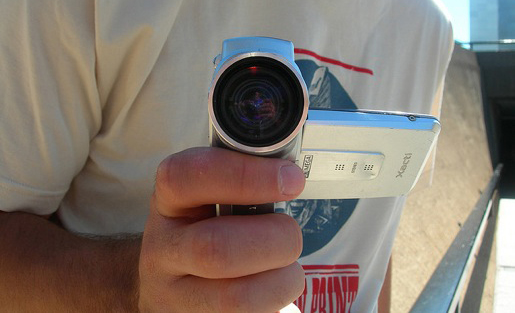The following opinion piece is a guest post. Read more about MediaShift guest posts here.
At SXSW, PBS made a bigger splash than usual at the media/tech mecca, with seven (!) panels and three films. At the new-this-year PBS Lounge (swag, free beer, comfy couches, selfies posted direct to Net), you could meet filmmakers of the three PBS premieres. PBS also announced investment in theatricals. And more than two dozen PBSers were on hand to court indies.
But it joined a throng of distributors — not just broadcasters but also online platforms — doing the same thing.
Competition
PBS has a lot of competition in its desire to lure indies to its brand. At the moment, PBS doesn’t even seem to make the radar of Variety, which just did a trend piece on the “golden age” of documentary without once mentioning it.
That competition wasn’t just coming from broadcast at SXSW, either, although HBO, CNN Films, ESPN, Al Jazeera and a host of European broadcasters were all prowling for content and deals. So were reps from online platforms. Showcasing their recent investments in indie production were, among others, Vimeo, YouTube, Netflix, EPIX (which is available both on cable and online) and AOL (yes, AOL). This is the year that online platforms became serious rivals for the content and talent broadcasters look for.
PBS had a respectable lineup of film premieres at SXSW; they were all films funded by ITVS, the production fund for indies within public TV. “The Best of Enemies” is an enormously entertaining recounting of the enormously entertaining 1968 debates between Gore Vidal and William F. Buckley, Jr. “Welcome to Leith” lets you watch as a neo-Nazi group takes over the town council of a tiny North Dakota town — and it’s not fiction. And then there’s the unforgettable surprising heart-stealer, “T-Rex.” Claressa “T-Rex” Shields, who aspires to be the first woman gold medalist in boxing at the Olympics, is an African-American high schooler saved from homelessness and domestic abuse by a sympathetic coach and his patient wife. And she’s also a phenom and a character. All will end up on Independent Lens or POV, the two major series showcasing independent documentary on public TV.
Welcome to Leith – Teaser from NO WEATHER on Vimeo.
Weirdly, at a panel promoting the opportunities for indies and PBS, PBS reps made no commitment to keeping these series in their primetime slots after rumored plans to move them generated enormous pushback from filmmakers and viewers. Panelist Byron Hurt, whose latest film “Soul Food Junkies” showed on Independent Lens in 2013, raised the issue: if “common carriage” (having all the stations carry the program at the same time) was too complex, he said, at least PBS should commit to their current primetime slot.
POV and Independent Lens also have audiences that skew younger and more diverse than PBS’ typical 60-plus. Indeed, PBS’ Donald Thoms actually reminded one hopeful indie that PBS programs for over 60s. PBS programmer Beth Hoppe, who brought a whole team to SXSW looking for potential pick-ups, jumped up from the audience to express her enthusiasm for younger audiences — without, however, committing to keeping the shows in primetime.
After the panel, one of the panelists, much-lauded indie Marshall Curry, noted that POV and Independent Lens are very indie-friendly: “POV and IL are supportive of filmmakers. They have huge audiences that dwarf most other broadcasters, and they allow directors to maintain creative control of their films, which is not always the case with other broadcasters.”
Diversity

Photo by Ed Schipul on Flickr and used with Creative Commons license.
Diversity was the subject of a PBS panel, which with refreshing frankness showcased ongoing diversity problems in broadcast. It featured two young women, Lauren Saks (PBS Digital) and Shereen Marisol Meraji (NPR CodeSwitch), who discussed how difficult it is for diverse content, like the kind they produce, to reach the center of attention on public broadcasting. Indeed, when asked if the digital side of PBS was able to carry its diversity orientation over to broadcast, Saks said, “We hope that the digital and the broadcast side get closer together, but broadcast just isn’t there yet.”
The two speakers also frankly discussed vitriolic hate comments on their sites about any topic touching race, even incidentally. They talked about how difficult it is to begin conversations on such difficult issues.
Engagement
At SXSW, where tech meets film, multi-screen, multi-platform and user engagement are all touchstone words. One panel “Analog and Digital: Synching an Engagement Campaign,” featuring “Last Days in Vietnam,” showed how it can work. Mark Samels, who heads “American Experience,” the series in which it appeared, walked through an elaborate engagement strategy, involving theatrical coordination with NPR’s StoryCorps, a digital platform for viewer stories, and crowdsourcing funds for outreach.
But unlike with Independent Lens and POV, where engagement is typical, Samels explained that this was an exception. “We make 10 films a year,” he said. “And only maybe one every other year goes into this kind of distribution. It’s the pressure of broadcast schedule.” He explained that only when it was out did they discover an enormous amount of appetite for the film in Asian immigrant communities.
PBS stations, added together, have unparalleled reach, and they can proudly display a brand that signifies trust throughout the United States and beyond. PBS could be a great partner for indies and appears to have powerful assets in house, but it faces stiff competition.
 This post originally appeared on the the site for the Center for Media & Social Impact, School of Communication, American University.
This post originally appeared on the the site for the Center for Media & Social Impact, School of Communication, American University.
Patricia Aufderheide is University Professor and Director of the Center for Media & Social Impact, School of Communication, American University, and co-author with Peter Jaszi of “Reclaiming Fair Use: How to Put Balance Back in Copyright” (University of Chicago Press). You can give feedback at [email protected].

